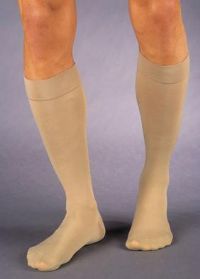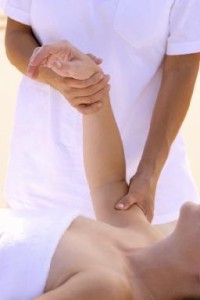Compression stockings are the mainstay of management of lymphedema. The importance of its daily use cannot be stressed enough, as without its there will be progression and worsening of the lymphedema.
The stockings are gradual gradient compression stockings, measured in mm Hg (millimeters of mercury) pressure, with the greatest pressure at the level of the  ankle, and progressive diminution in the pressure up to the level of the knee. Compression hose function to aid the muscles of the forefoot and the calf; also known “the muscle pumps”, return fluid back towards the heart. As these “muscle pumps” only exist in the muscles of the forefoot and calf, there is generally no need for use of stockings above the level of the knee.
ankle, and progressive diminution in the pressure up to the level of the knee. Compression hose function to aid the muscles of the forefoot and the calf; also known “the muscle pumps”, return fluid back towards the heart. As these “muscle pumps” only exist in the muscles of the forefoot and calf, there is generally no need for use of stockings above the level of the knee.
The appropriate compression grade is decided by the degree of swelling, and the integrity of the skin, e.g. dry skin, or skin color changes. The goal is to use the lowest compression grade that will appropriately treat the lymphedema, and prevent its progression. Also the appropriate placement of the stocking is key to success; remembering when lying flat no stocking is necessary, as the legs and the heart are on the same plane. However, when standing there is a “hill” to climb, so placing the stocking prior to the leg being dependent is crucial to it successful In situations where the stocking alone is inadequately treating the underlying process, adjunctive measures can be added to the treatment protocol. One of these is manual lymphatic decompression (MLD), a technique of massaging the lower extremity from the periphery to the center, in order to stimulate “collateral” lymph drainage. This enables the lymph channels to work more effectively, by increasing the size of these “collateral channels”, and this increased diameter increases the amount of fluid return, thus reducing the swelling of the lower extremity. MLD is performed by specialist trained in this technique, either physiatrists, physical therapist, or lymphedema specialists. There is an online resource to search for an appropriate therapist that performs this technique.
Alternatively there is another adjunctive option–lymphedema pump. This entails placing a plastic sleeve on the forefoot and on the calf which is then connected by a tube to a power source, and sequential compression occurs which helps in recirculating the lymphatic fluid. There are also available wearable mobile device with an internal battery pack the can also be used in the same fashion. Use of the pump several times per day is important to help reduction of the lymphedema
placing a plastic sleeve on the forefoot and on the calf which is then connected by a tube to a power source, and sequential compression occurs which helps in recirculating the lymphatic fluid. There are also available wearable mobile device with an internal battery pack the can also be used in the same fashion. Use of the pump several times per day is important to help reduction of the lymphedema
Whether using either the MLD, or the lymphedema pump as adjunctive measures, continued use of a compression hose with daily activity still necessary, as when the leg is dependent there is the possibility of accumulation of lymph fluid. Lymphedema is chronic lifelong condition. Attention to detail is crucial in the prevention of worsening of this condition; it is imperative to make sure that the compression stocking that you are using does not wear out. As the stocking is made of material including spandex, over time the elasticity and compressibility of the stocking deteriorates. Also it is important to adequately moisturize the skin to maintain skin integrity, and if possible whenever sitting to elevate the leg.
Be aware of the early signs of potential deterioration in the condition of the extremity, and seek medical care earlier rather than later, to prevent serious consequences.
Finally, be active in your care, and try to learn as much as possible about this condition, so that you can prevent consequences. There is much information on the Internet that is readily available to the public, including lymphedema societies that are directed towards patient needs.


